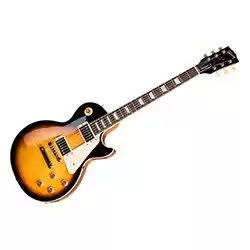Are you having trouble achieving a good sustain on a guitar? Do you need some ideas to help you fix that situation?
This guide will take you through what it takes to improve guitar sustain.
How Long Is Good Sustain on a Guitar?
Every guitar provides a different sustain, which is how long the instrument can play a specific note or chord. Some designs ring out for five seconds or less, while others deliver 30 seconds or more. The string must continue vibrating after the initial attack, which means the musician’s strength also plays a role.
Most heavy, dense guitars tend to have the longest sustains in the marketplace. The Les Paul is well known for its ability to hold notes and chords for 30 seconds or more.
This outcome is possible because the solid body doesn’t absorb string vibration, allowing the energy to remain where the audio production occurs.
That’s why a Les Paul holds a note for forever.
The string itself produces minimal sound. That’s when electric guitars must have amplification to have the sustain heard.
Every guitar can deliver a better sustain when you take the right approach to the instrument.
What Are the Best Ways to Improve Sustain?
In a perfect world, you could build a guitar at a custom shop that had all the qualities you want in an instrument. That’s how many artists achieve a signature sound.
If you’re not a music superstar, you’re probably focused more on paying the rent or putting food on the table.
That’s okay – many of the ways to improve the sustain on a guitar use a DIY approach. Take a look!
1. Lower the Pickups
Pickup height has a dramatic impact on the amount of sustain a guitar produces. Most players today have their pickups placed rather high, nearly touching the strings. The goal is to increase the output, but that leads to shorter notes.
Pickups contain magnets that produce magnetic fields that interact with the instrument’s strings. If they’re too close, the pull is strong enough to prematurely stop vibration. That leads to less sustain.
Lowering the pickups changes that resistance to create longer notes.
2. Dial in the Settings
The stock strings on a guitar are usually pitiful. One of the best things you can do to improve sustain is to swap them out for something new.
My personal favorite is the nickel wound EXL110-3D from D’Addario. These XL strings deliver a pure, iconic tone that helps me create unique tones for each composition.
Once you’ve got the new strings on, start working with the instrument’s settings. Different combinations of tone and volume have a direct impact on how the guitar operates.
3. Adjust the Amp
If you’ve noticed lackluster sustain with your guitar after it used to kill it, the problem could be with your amp.
The primary setting that increases this trait is the gain or master control, but that can cause the audio to be muffled or slurry.
Another option with the amp is to increase the frequencies in the mid or lower register. Your tone gets more depth that way without increasing the gain.
4. Use Thicker Strings
By stepping up a gauge or two with your guitar strings, you can increase the sustain the instrument produces relatively quickly.
Thicker strings have more tension, allowing them to vibrate longer. If you’re using a .009 set, up it to .010 to see what happens.
You can always go higher than that, but the thickness can change your playing style a little. Increasing in adjustments ensures that you can build up strength where it’s needed.
5. Change the Nut
The nut on an entry-level electric guitar is typically made of plastic. That material deadens vibrations faster than other materials, which leads to a premature end to the sustain. Try upgrading it to metal or bone for a better result.
Bone nuts come in either a cut or uncut state. If you don’t mind working with blanks and can carve lines for the strings, you’ll find that the Vencetmat six-piece set delivers the sustain and versatility you want.
When you prefer something that is ready to install right away, you’ll want to verify compatibility before finalizing your purchase.
I’m a big fan of the Fender Vintage Style Bone Nut because it delivers that trademark sound for Strats and Teles while upgrading cloned designs to get closer to a similar result.
6. Use Different Picks
A thicker and harder pick delivers a better sustain for most guitars.
That’s because the musician can pluck the strings harder, allowing them to vibrate longer. Guitar picks come in four standard gauges today.
- Thin (0.6 mm or thinner).
- Medium (0.6 to 0.8 mm).
- Heavy (0.8 to 1.2 mm).
- Extra Heavy (1.2 mm or thicker).
I love using metal picks to produce the most sustain, but you can also try celluloid designs.
When you’re using one made from leather, rubber, nylon, or wood, the tone quality tends to be softer since fewer vibrations occur.
If you’re using a flexible or thin pick to play your guitar, swap it out for a harder or a thicker one to get the sustain benefits you want.
Best Guitar for Sustain to Play Right Away
The best guitars for sustain for me have always come from Gibson. Although some of those instruments can weigh more than 12 pounds, it’s worth the punishment when you’re ready to crush a fantastic note on a solo or to end a piece.
When you want massive sustain, you’ve got to go with a solid mahogany body. That extra weight stops vibration transfer, allowing you to stand there and hold notes for an eternity.
That’s why I love the Gibson USA LP Standard. This 1950’s style guitar uses the Tobacco Burst motif with a non-weight modified mahogany body, maple, and rosewood to deliver an impressive sound.
It uses a 22-fret design, acrylic trapezoids, and the classic Tune-O-Matic tailpiece to provide the vibe you want on stage.
The guitar comes equipped with two humbuckers loaded with Alnico II magnets. The wiring uses orange drop capacitors and audio taper potentiometers.
When you let this guitar ring to its fullest extent, you’ll get between 20 to 30 seconds each time. If I attack a heavier gauge right, it’s been known to hit 45 seconds with barely any fade.
Best Guitar for Sustain Under $1,000
When a Les Paul or Gibson LP isn’t what you like to play, I highly recommend grabbing an ESP LTD EC-256FM guitar. It comes with several different color options, although I’m partial to the purple sunburst look.
It isn’t as heavy as a Les Paul, but ESP still uses mahogany in the body to give you a better sustain.
I love how the jatoba fingerboard adds a quickness to my playing style, and the passive pickups are suitable for nearly any genre.
You can play metal, classic rock, blues, and more with a few setup changes each time.
If I had to pick a favorite feature about this ESP guitar, it would be its neck shape. I’ve got a relatively large hand, which means my thumb tends to get in the way of some chords when there’s a slim profile. This design fits me just right.
It won’t play for days on the sustain like a heavier model, but I can still get about 20 or 25 seconds with most of my setups.
Best Guitar for Sustain Under $500
For an entry-level guitar, the G-Style LP Six-String Electric Guitar puts on an impressive show. It starts with the visuals, delivering a brilliantly bold cherry burst look that demands attention. The piece is surprisingly light for the sustain it can produce, helping me become more of a fan of Okoume wood.
You have two tone and two volume controls to use with this guitar. It offers the same 22-fret design, a classic scale length, and a double humbucker setup that lets you groove or slam your tone in whatever way you prefer.
It is a little tough to keep in tune, but that’s an issue with many entry-level guitars. You can fix that issue by upgrading to the nickel wound EXL110-3D strings from D’Addario.
How Much Sustain Do I Need for a Guitar?
Playing clean means there is a focus on appearance, playability, tone, and sustain. Musicians can play with the gain settings to add or subtract what they want for any situation. The goal is to give the audience what they want to hear while having a fun time hitting the chords and notes of a favorite song.
Although I’ve had guitars that get close to a minute of sustain, I’ve rarely found that much to be useful unless I’m jamming out with my buddies.
From a practical playing view, having 15 to 20 seconds of sustain is a reasonable expectation for any guitar. Some instruments hit that rate consistently, while others needed to be guided or upgraded to reach that result.
After replacing the stock strings and upgrading the nut, consider toying with the tone and volume to see what happens. You might be surprised by the results that happen!






